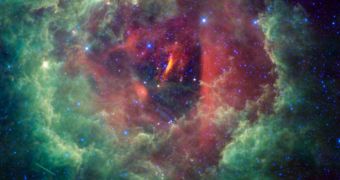A team of experts from the NASA Jet Propulsion Laboratory (JPL), in Pasadena, California, announces that the WISE telescope has recently snapped a new, impressively-detailed photo of the Rosette nebula.
The beautiful cosmic structure is a stellar nursery located in the constellation Monoceros (the Unicorn), some 4,500 to 5,000 light-years away from Earth.
The Wide-field Infrared Explorer (WISE) is a new NASA space telescope that is extremely sensitive to infrared wavelengths. This makes it especially well suited for conducting studies on stellar nurseries.
Generally, these cosmic features are surrounded by massive clouds of cosmic hydrogen and dust, which together help form protostars. But these shrouds also prevent observatories from peering into the structures using visible wavelengths.
Stellar nurseries are areas of stellar formation, where massive hydrogen clouds eventually collapse onto themselves due to excessive gravity, igniting in the processes, and giving birth to new, blue stars.
Infrared detectors can penetrate the thick layers of dust surrounding these areas, and reveal the formation process of stars beneath. The Rosette nebula (NGC 2237) is no exception, the JPL crew says.
In this image, the young stellar cluster known as NGC 2244 is clearly visible in the center of the cosmic “rose”. Also visible in the lower left part of the image is a streak, which was produced by the passing of a satellite in WISE's field of view.
This particular photo is made up of several snapshots, and one of them inadvertently captured the satellite.
The hole-like structures at the center of this view is caused by powerful solar winds, emitted by young, massive stars born in the cluster.
The radiation they emit erode at nearby gas and dust clouds, stirring them up, and eventually promoting even more intense stellar formation.
Rosette is difficult to see by amateur astronomers, but the NGC 2244 star cluster can be easily observed with a small telescope, or even a good pair of binoculars. The cluster was first observed in 1690 by English astronomer John Flamsteed, but it wasn't until 150 years later that John Herschel discovered the nebula surrounding it.
John Herschel was the son of William Herschel, the scientist who discovered infrared light, and the one after whom the new telescope operated by the European Space Agency (ESA) is named.
The WISE mission is managed by the JPL for the NASA Science Mission Directorate, in Washington DC.

 14 DAY TRIAL //
14 DAY TRIAL //